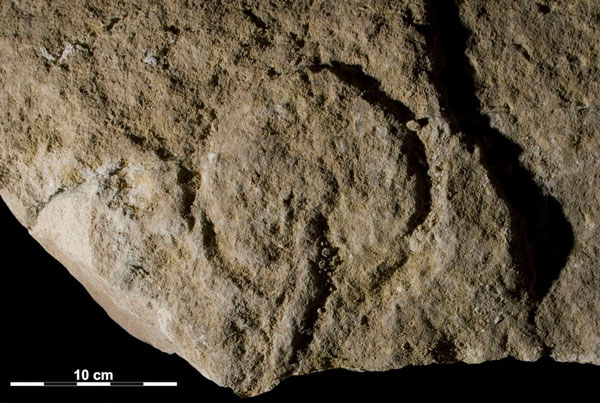Why do ancient Europeans like female genital engraving stations?
The oldest rock art ever found in Europe reveals interest in women's body parts. This is a model that ancient Europeans like to decorate their living space.
New discovery at a site called Abri Castanet in France consists mainly of circular carved stations that look very much like the female genitals. These carvings were created on the ceiling of a stone tunnel 37,000 years ago but now have collapsed, scientists said in the PNAS issue on May 14.
'It is everyday art. It's right above their heads when they go back and forth, " said Randall White, an anthropologist at New York University.
Ancient artists created ceiling decorations of the cave that were the first in Europe. They formed a group called the Aurignicia . They came from Africa, then replaced the Neanderthals in Asia.

One of the stone carving pictures found. (Source: Livescience)
White said, they are people living by hunting and gathering, forming a relatively complex society. They know painting, engraving and sculpture. Their jewelry consists of beads made of mammoth ivory, animal teeth and seashells in the Mediterranean and Atlantic Ocean.
The Aurigicia spent the winter in southwestern France, perhaps according to a group of 300 people. They live in caves about 7m deep and about 2m high. On the ceiling, they chiseled stones to create many circular symbols that looked like female genitals. (Scientists are still arguing this is female genitalia or something else). Other places in Europe's caves also have similar carved stations.
Abri Castanet Great Site has been excavated since 1911, but archaeological excavations at the time were not as advanced as it is today. That day, archaeologists found evidence of stone artifacts, but they could not determine where and how many art drawings came from.
White and his colleagues excavated the top down. When the cave collapsed, it fell to the correct artifacts of the Aurignicia inhabitants, helping researchers determine the time of the residence to 37,000 years ago.
- New discovery about the origin of modern Europeans
- Signs of warts and treatment
- Secret female contraceptive weapons of female dolphins
- The wave migrated to Europe at the end of the Ice Age
- Comedy female soldier in ancient tomb 1,000 years
- Vietnamese prodigy makes laser engraving machines from scrap
- 'Armed race' in the genital organs of ducks
- Detecting female sexual hormones in plants
- The mystery of the female remains is crowning in ancient thousand-year tombs in China
- Extend life for wounded soldiers with female sex hormones
- Oestrogen makes the female brain bigger?
- Europeans used to have dark skin
 Discovered an ancient centipede fossil 99 million years old
Discovered an ancient centipede fossil 99 million years old Discovered bat-like dinosaurs in China
Discovered bat-like dinosaurs in China Discovered a 200-year-old bronze cannon of the coast
Discovered a 200-year-old bronze cannon of the coast Discover 305 million-year-old spider fossils
Discover 305 million-year-old spider fossils